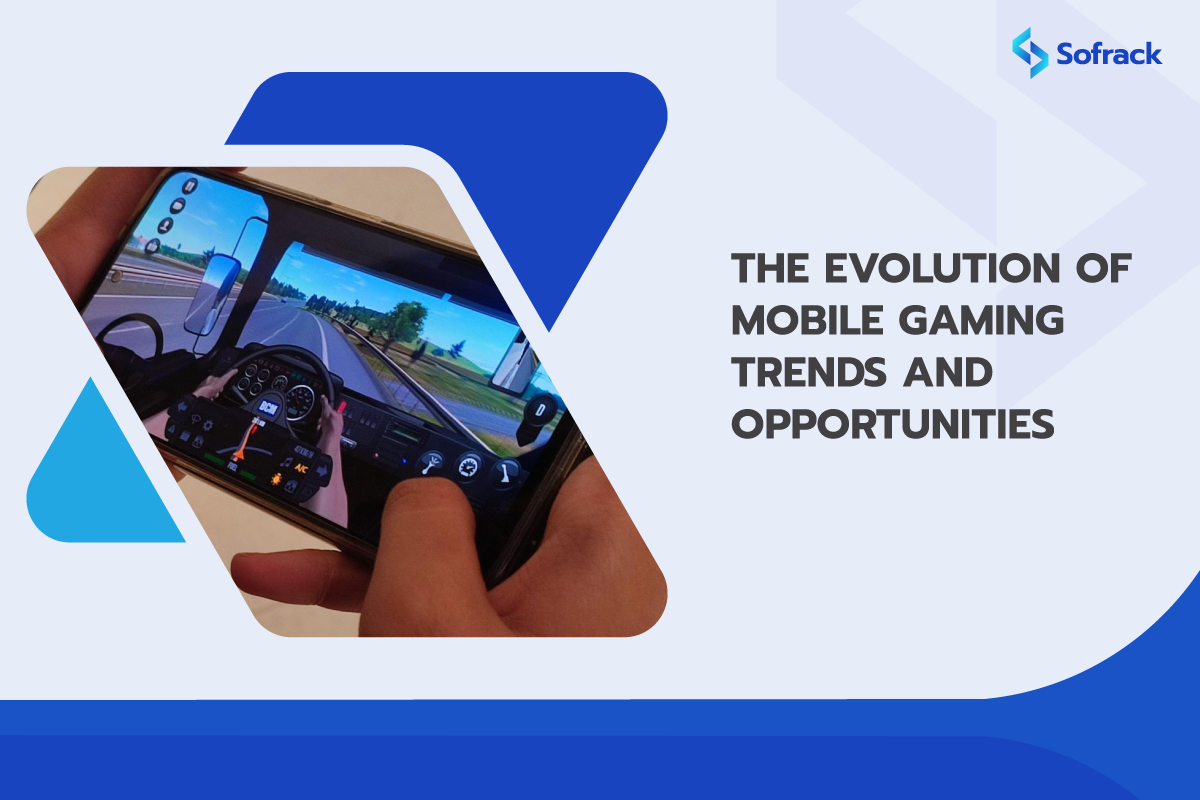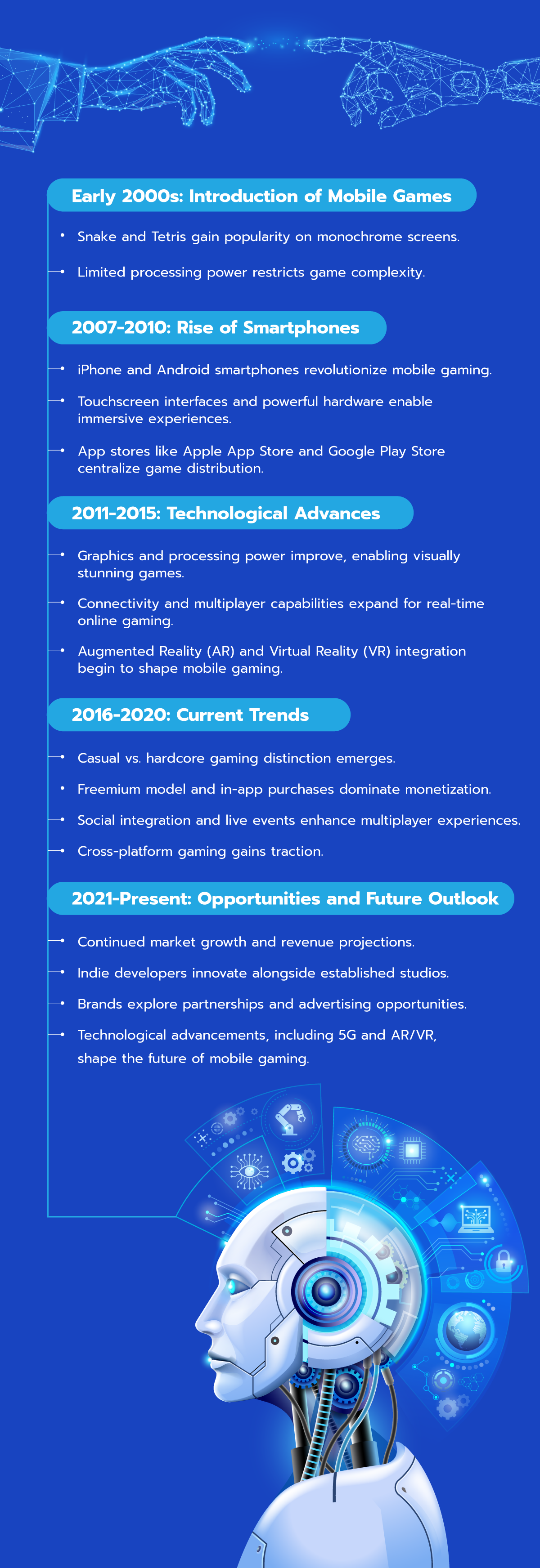Remember the days when all you had was a pixelated snake slithering across the tiny screen of your old mobile phone? Back then, that simple game was the epitome of mobile entertainment. But oh, how times have changed! Today, in the palm of your hand, you have everything you can imagine – from epic battles in fantasy realms to adrenaline-pumping races through futuristic cities. In the blink of an eye, we’ve journeyed from the quaint simplicity of snake to the breathtaking complexity of mobile gaming as we know it today. The evolution has been nothing short of extraordinary, transforming our handheld devices into portals to infinite worlds of adventure, strategy, and wonder.
So, buckle up and prepare to be amazed. The age of mobile gaming is here, and the possibilities are limitless. Let’s dive in!
Early Trends in Mobile Gaming
In the early days of mobile gaming, the concept was as simple as the devices themselves. As mobile phones began to integrate basic gaming capabilities, developers seized the opportunity to provide users with entertainment on the go. However, the limitations of technology meant that early mobile games were often rudimentary, constrained by the hardware and software capabilities of the devices.
One of the major challenges faced by early mobile game developers was the limited processing power and graphical capabilities of mobile devices. Early mobile phones lacked the processing power and memory to support complex games, resulting in simple graphics and gameplay mechanics. Furthermore, the diversity of mobile platforms and operating systems posed additional challenges for developers, who had to contend with fragmentation and compatibility issues when creating games for different devices.
These technological constraints not only limited the scope of mobile games but also influenced the types of games that were popular during this era. Simple, arcade-style games with straightforward gameplay mechanics were favored, as they could run smoothly on a wide range of devices without taxing their limited resources.
Popular Early Mobile Games: Despite the technological limitations, several early mobile games achieved widespread popularity and became iconic classics in the world of mobile gaming. Among these early favorites was “Snake,” a simple yet addictive game where players controlled a snake as it navigated a grid, eating dots and growing longer with each meal.
Another notable title was “Tetris,” a timeless puzzle game that captivated players with its deceptively simple gameplay and addictive mechanics. “Space Impact” and “Bounce” were also among the early hits, offering players a mix of action, strategy, and skill-based challenges.
These early mobile games laid the foundation for the future of mobile gaming, demonstrating the potential for entertainment on the go and paving the way for the innovative experiences that would follow in the years to come.
Key Technological Advances Shaping Mobile Gaming
Graphics and Processing Power: Thanks to advancements in mobile GPU technology and faster processors, modern smartphones are capable of rendering complex 3D graphics in real time, allowing for immersive gaming experiences that were once only possible on high-end gaming PCs or consoles. Furthermore, improvements in display technology, such as higher resolutions and faster refresh rates, have enhanced the visual fidelity of mobile games, making them more vibrant, detailed, and engaging than ever before.
Connectivity and Multiplayer Capabilities: Another significant technological advance that has shaped mobile gaming is the proliferation of high-speed internet connectivity and the development of robust multiplayer capabilities. With the advent of 4G and now 5G networks, players can enjoy seamless online multiplayer experiences on their mobile devices, connecting with friends and competitors from around the world in real time. These advancements have not only made multiplayer gaming more accessible but have also enabled the rise of esports on mobile platforms. Mobile games like PUBG Mobile and Call of Duty Mobile have attracted millions of players worldwide, hosting competitive tournaments with prize pools rivaling those of traditional sports. Furthermore, social features such as chat, voice communication, and social media integration have enriched the multiplayer experience, fostering communities and friendships among players who share a passion for mobile gaming.
Augmented Reality (AR) and Virtual Reality (VR) Integration: AR and VR technologies have also made significant strides in shaping the future of mobile gaming. AR games overlay digital content onto the real world, allowing players to interact with virtual objects and characters in their physical environment. Games like Pokémon GO have demonstrated the immense potential of AR gaming, captivating players with its innovative blend of real-world exploration and virtual creature-catching mechanics. Similarly, VR gaming immerses players in virtual environments, transporting them to fantastical worlds and challenging their senses in new and exciting ways. While AR and VR gaming are still relatively nascent compared to traditional mobile gaming, continued advancements in hardware and software are driving innovation in these fields. As technology continues to evolve, we can expect to see even more groundbreaking AR and VR experiences on mobile devices, further blurring the lines between the virtual and the real.
Current Trends in Mobile Gaming
Casual vs. Hardcore Gaming: In the diverse landscape of mobile gaming, one prominent trend is the distinction between casual and hardcore gaming experiences. Casual games are typically easy to pick up and play, requiring minimal time investment and catering to a broad audience of players. These games often feature simple mechanics, and short play sessions, and are well-suited for gaming on the go. On the other hand, hardcore games offer deeper gameplay mechanics, longer play sessions, and more complex challenges. These games appeal to dedicated gamers who are looking for immersive experiences that rival those of traditional gaming platforms. Titles like Fortnite Mobile and Genshin Impact have successfully captured the attention of hardcore gamers, offering console-like experiences on mobile devices. The coexistence of casual and hardcore gaming reflects the diverse preferences of mobile gamers and highlights the versatility of the platform in catering to different play styles and interests.
Freemium Model and In-App Purchases: The freemium model, which offers games for free while generating revenue through in-app purchases (IAPs), continues to dominate the mobile gaming industry. This model allows developers to attract a large player base by removing the barrier to entry while monetizing their games through optional purchases of virtual goods, power-ups, or additional content. While some players appreciate the opportunity to enjoy games for free, others criticize the freemium model for its potential to create pay-to-win scenarios and exploit players’ propensity for impulse spending. Nonetheless, when implemented responsibly, the freemium model can provide a sustainable source of revenue for developers while offering players the freedom to choose how they support their favorite games.
Social Integration and Live Events: Social integration has become an integral part of mobile gaming, with developers increasingly leveraging social features to enhance the multiplayer experience and foster community engagement. From in-game chat and friend lists to guilds and clans, mobile games provide numerous opportunities for players to connect, collaborate, and compete with one another. Moreover, live events and community challenges have become a staple of mobile gaming, offering players the chance to participate in limited-time events, earn exclusive rewards, and compete for bragging rights. These events not only drive player engagement but also create a sense of excitement and urgency that keeps players coming back for more.
Cross-Platform Gaming: Cross-platform gaming, which allows players to access their game progress and play with friends across multiple devices and platforms, is gaining traction in the mobile gaming industry. With the rise of cloud gaming services and cross-platform development tools, players can seamlessly transition between mobile devices, PCs, and consoles without losing their progress or missing out on multiplayer experiences. Games like Fortnite, Minecraft, and Among Us have embraced cross-platform play, enabling players to team up or compete against each other regardless of their preferred gaming device. This trend not only promotes inclusivity and accessibility but also opens up new opportunities for collaboration and competition in the world of mobile gaming.
Opportunities in Mobile Gaming Industry
Market Growth and Revenue Projections: The mobile gaming industry is experiencing unprecedented growth, driven by increasing smartphone penetration, advancements in technology, and shifting consumer behaviors. According to industry reports, the global mobile gaming market is projected to continue its upward trajectory, with revenue expected to surpass billions of dollars in the coming years. This exponential growth presents abundant opportunities for developers, publishers, and investors to capitalize on the booming mobile gaming market. With a diverse range of gaming genres and demographics to cater to, there is ample room for innovation and expansion within the industry.
Game Development and Monetization Strategies: As the mobile gaming market continues to evolve, developers must stay abreast of emerging trends and adopt effective monetization strategies to maximize their revenue potential. While traditional models such as premium pricing and in-app purchases remain popular, developers are increasingly exploring alternative monetization methods such as subscriptions, ad-based revenue, and loot boxes. Moreover, successful game development requires a keen understanding of player preferences, market dynamics, and technological advancements. By leveraging analytics, user feedback, and market research, developers can create engaging and profitable games that resonate with their target audience.
Opportunities for Indie Developers: The democratization of game development tools and platforms has empowered indie developers to break into the mobile gaming industry and compete alongside established studios. With platforms like Unity, Unreal Engine, and GameMaker Studio, indie developers can create high-quality games with relatively low barriers to entry. Furthermore, the rise of digital distribution platforms and crowdfunding sites has provided indie developers with avenues to showcase their work, build a loyal fanbase, and secure funding for their projects. This democratization of game development has fostered a vibrant ecosystem of creativity and innovation, with indie developers contributing fresh ideas and unique experiences to the mobile gaming landscape.
Potential for Brand Partnerships and Advertising: Mobile gaming presents lucrative opportunities for brands to engage with consumers in a meaningful and interactive way. Through strategic partnerships, product placements, and in-game advertising, brands can reach a captive audience of millions of players and drive brand awareness, engagement, and sales. From sponsoring in-game events and competitions to creating branded content and experiences, brands can leverage the immersive nature of mobile games to connect with consumers on a deeper level. Moreover, with the rise of influencer marketing and social media integration, brands can amplify their reach and impact by partnering with popular gaming influencers and content creators.
The evolution of mobile gaming is a testament to the boundless creativity, innovation, and ingenuity of the human spirit. From humble beginnings as pixelated distractions on monochrome screens to immersive experiences that rival traditional gaming platforms, mobile gaming has come a long way in a relatively short period. In conclusion, the evolution of mobile gaming is a testament to the power of technology to inspire, entertain, and connect us in ways we never thought possible. As we continue to push the boundaries of what’s possible, one thing is clear – the future of mobile gaming is bright, and the opportunities are limitless.
So, whether you’re a player, a developer, or a brand, buckle up and get ready for an exhilarating ride through the ever-expanding universe of mobile gaming. The adventure has only just begun.

